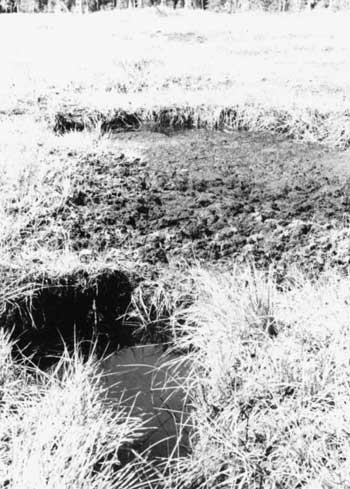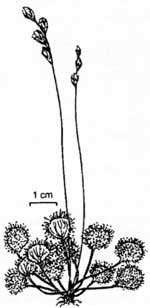|
Volume XXV - 1994
Hiking in a Montane Mire
By Jean Danielson and Steve Mark
Sphagnum Bog is one of many charming areas in Crater Lake National
Park. It is four miles west of the lake, but an easy hike from the
Rogue River National Forest. The trail to Sphagnum Bog can be reached by
taking state highway 230 and turning east at the sign for National Creek
Falls. Use forest road no. 6536 to go east, then spur road 660 to find
the trailhead. It is only about one quarter mile to the park boundary
once you are on the trail.
On the way into Sphagnum Bog, you may be lucky enough to see a
number of rare and interesting plants. One with a small purple-blue
flower is Mount Mazama collomia, Collomia mazama. If you see
one, note its location and report your find on the observation cards
available at park visitor centers. Remember, as with all flowers in the
park, do not pick or allow anything to harm it.
In roughly a mile and a half, the access trail intersects with the
so-called Bald Crater Loop. Go south to Crater Springs and cross the
creek once to reach the bog. The total distance to the bog is 2 1/4
miles. Upon finding the wetland area, a deep sense of the primordial can
be felt. Amid the bog's hollows and mounds of vegetation, you should
find that sphagnum becomes more obvious. This genus is represented by
two species in the bog, S. squarrosum and S. subsecundum
Sphagnum has large open cells which make it seem like a sponge to the
touch. This is because most members of the genus have the ability to
hold 20 or more times their dry weight in water.
Sphagnum is a moss which grows only in water and has the ability to
acidify its surroundings. Although it grows continually upward, Sphagnum
is balanced by decay at the bottom of the plant. Its partial
decomposition in water forms peat. Varying in consistency from turf to a
slime, peat further decomposes to a dark brown or black and can impart a
tea color to standing water.
Boggy peatlands characterize much of the British Isles, northern
Canada, and other places in the upper latitudes. Sphagnum bogs in those
areas usually have relatively few nutrients and harbor acid-tolerant
vegetation such as pitcher plants, sundew, or heaths. The park's
sphagnum bog is somewhat different than the boggy peatlands, though it
is a peat producing ecosystem. It is classified as a montane mire, which
are relatively common in subalpine regions of the Cascade Range where
moisture accumulates in small basins or in poorly-drained slopes.
Sphagnum Bog is an area that is saturated most of the year. The
trail will bring you to the headwaters of Crater Creek, which is fed by
two large springs. This part of the Crater Creek basin is relatively
flat and poorly drained in comparison to other spring areas on the
park's western boundary. Along with sedges and shrubs, Sphagnum forms a
carpet of vegetation in many wet areas of this bog. Water beneath
this
carpet can be deep, so be careful or you may be struggling to free
yourself from the mud. Most of the wet areas can be avoided by staying
to the forest or shrub communities which surround the bog.

One of Spaghnum Bog's pools
Photo by Roger
Brandt.

bog blueberry
Hickman, pp. 569 &
543.
|
These plant communities also illustrate the slow process of plant
succession in the mire. In contrast to the boggy peatlands, the park's
sphagnum bog is not dominated by Sphagnum. Being relatively high in
nutrients, this montane mire is characterized instead by brown mosses,
shrubs, and sedges. Plant succession began with sedge communities
establishing themselves on gentle slopes where seepage from the two
springs drainage accumulated. Thickets of boa blueberry, Vaccinium
occidentale, followed at the basin's edge. Conifer invasion of the
mire, however, has been somewhat retarded. A limiting factor is probably
the prevalence of peat.
The peat in Sphagnum Bog averages six feet deep and is underlain by
pumice. Mount Mazama's eruptions produced the pumice, though formation
of the mire presumably began when a cool, wet trend in the region's
climate developed about 4000 years ago. At that time, sedges and herbs
began invading shallow pools which had formed over poorly drained
areas.

sundew
Hickman, pp. 569 & 543.
|
What eventually developed at Sphagnum Bog is a fascinating mosaic of
vegetation highlighted by the wetland's deep pools and insectivorous
plants. The pools are sometimes called kettle holes, though this is a
misnomer because Sphagnum Bog is not glacially-carved. They are five
feet or more in depth and located in the lower portion of Sphagnum Bog's
eastern arm. Two species of sundew, Drosera anglica and
Drosera rotundifolia, and three bladderworts, Utricularia,
feed on insects. The sundew trap bugs with sticky hairs that bend over
once the prey is caught. When the insect dies, the hairs secrete a
digestive juice that breaks down the soft parts of the insect's body.
The soluable products are then absorbed and used by the plant.
Despite some wet footwear and pant legs, a day spent at Sphagnum Bog
will provide an experience with a rich variety of plant habitats in a
fairly small area. If you are fortunate, a large number of birds and
mammals may also be seen. Like other wetlands, Sphagnum Bog is a place
that provides a memorable contrast to drier forest areas in the park.
But keep your eyes open for Sphagnum so that you will avoid an
unexpected encounter with the bog's deep pools!
Further Information
Susan Seyer, Vegetative Ecology of a Montane Mire, Crater Lake
National Park, Oregon. M. S. Thesis, Oregon State University,
Corvallis, 1979.
| 
